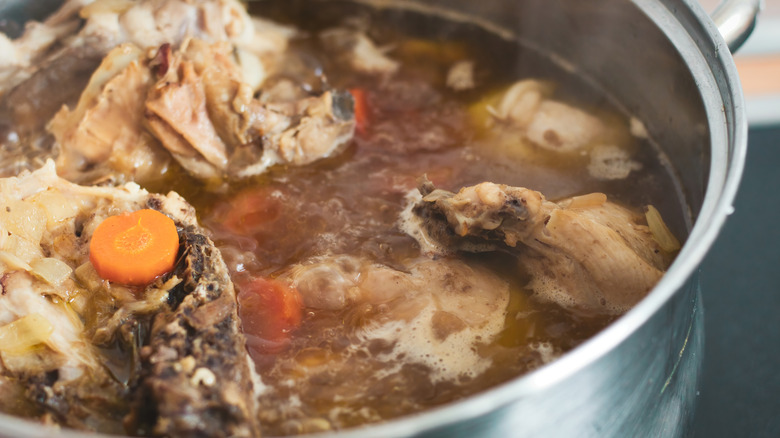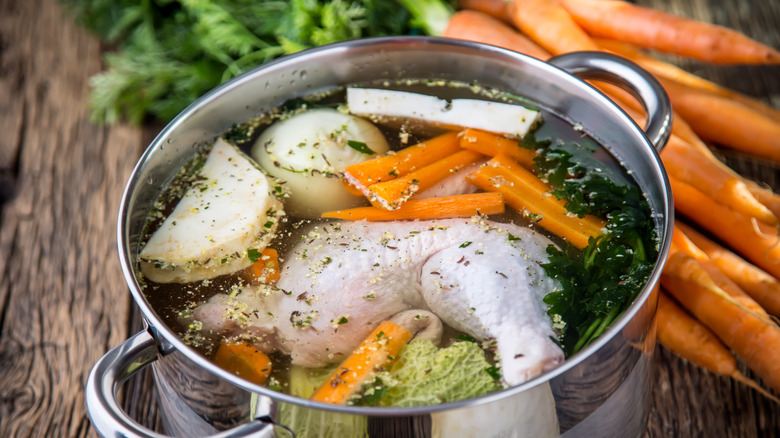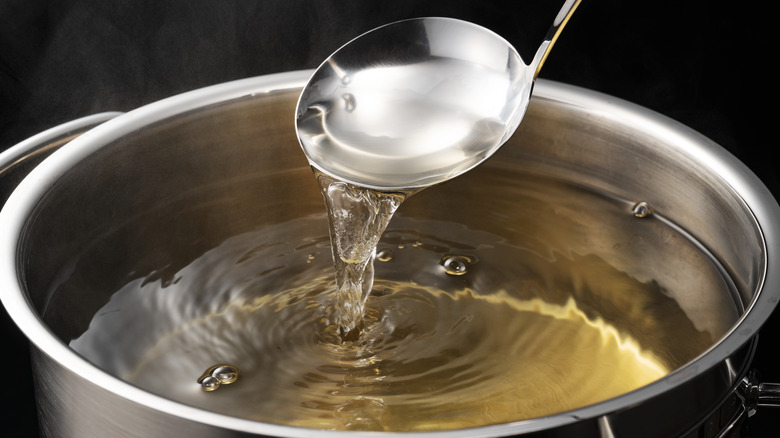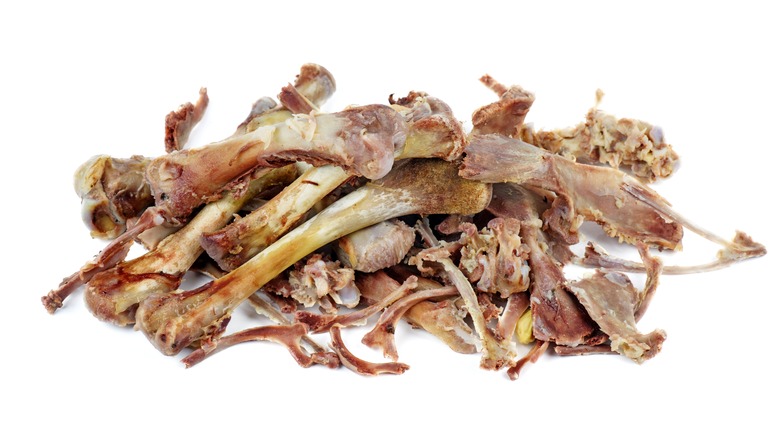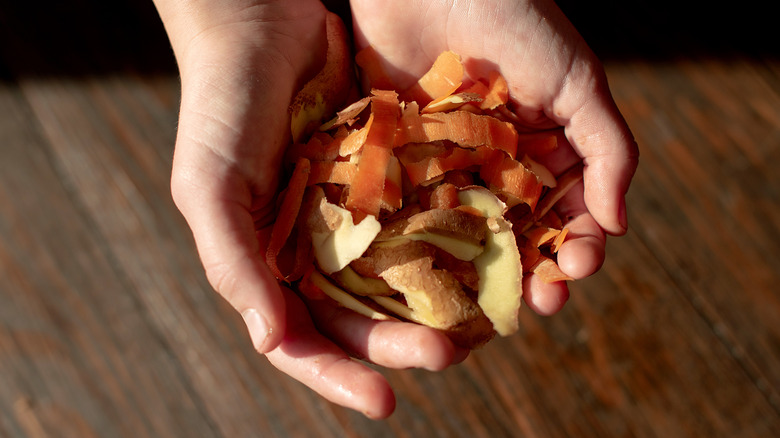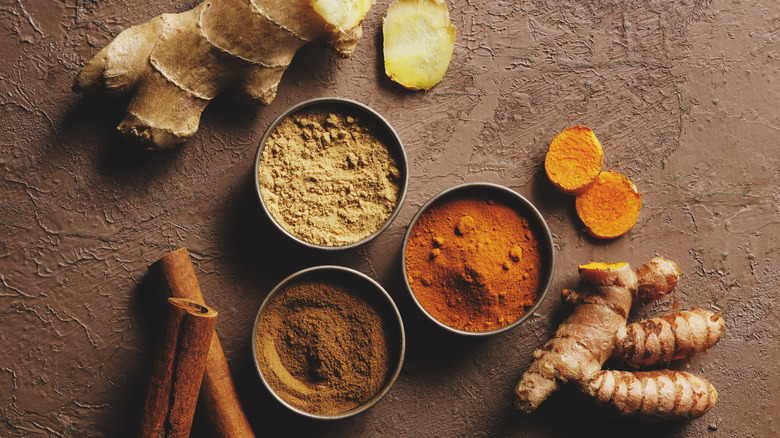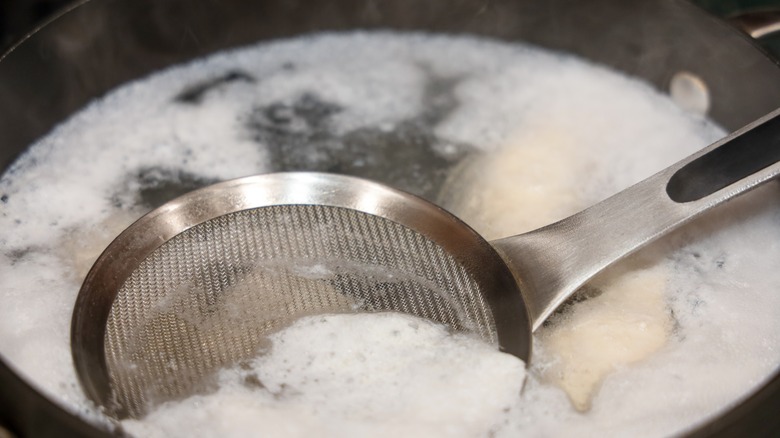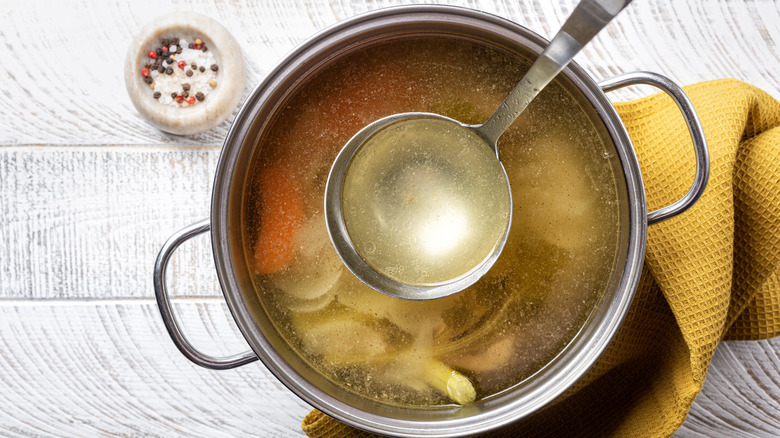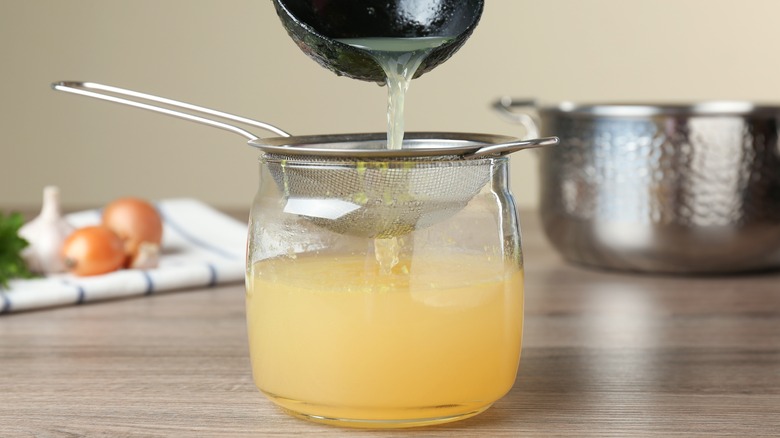Your Step-By-Step Guide To Making A Deeply Flavorful Stock
Making your own stock is a culinary skill that can elevate your cooking to new heights. Whether you're an experienced chef or a home cook looking to enhance your meals, mastering the art of stock-making opens up a world of flavor and possibilities. It also provides a depth and richness that store-bought versions simply can't match.
Anthony Bourdain wrote in his "Kitchen Confidential" book, "Stock is the backbone of good cooking." Indeed, in the professional kitchen, stock is the foundation of many dishes, from soups and stews to sauces, risottos, braises, gravies, and probably whatever else you're eating that tastes deeply flavorful and complex. As a professional cook, I make stock almost weekly at home for my own cooking. Back on the job, most kitchens I've worked in made fresh stock almost every day to keep up with production.
This guide will walk you through the essential steps and tips for creating a perfect stock every time. We'll cover everything from the basics of what stock is to the tools you'll need and the best practices for extracting maximum flavor from your ingredients. You'll learn how to prep and handle your bones and vegetables, the importance of simmering low and slow, and how to incorporate herbs and spices to build layers of complexity in your stock. We'll also share practical tips for saving money and reducing waste, and provide guidance on storing and preserving your stock for future use.
Know the basics of stock
Stock is a flavorful liquid made by simmering bones, vegetables, and aromatics in water. As mentioned, it serves as a versatile foundational ingredient by adding depth and richness to many recipes, and it can be tailored to different cuisines. As an essential skill for any home cook or professional chef, mastering the art of stock-making ensures you make the most out of ingredients that might otherwise go to waste. So understanding the science behind stock is important: as bones simmer, they release collagen, which breaks down into gelatin, giving the stock body and a silky texture. Vegetables (like mirepoix), herbs, and spices contribute additional flavors and nutrients. The slow simmering process allows for the gradual extraction of flavors, resulting in a complex and balanced end product. That's your stock!
Confused about the difference between stock and broth? It's simple. Basically, stock is made from bones and scraps and simmered for hours, whereas broth is made from meat and/or vegetables and simmered for a shorter time. That said, both have collagen and protein, and the two are often used interchangeably, so context is key.
Have the right tools for making stock
To make stock the right way, having the right tools is super important. A large stock pot is crucial to accommodate the bones, vegetables, and water without overcrowding. A good ladle, or at least a big metal spoon, is necessary for skimming impurities off the surface and for portioning the finished stock. A fine mesh sieve or cheesecloth is indispensable for straining the stock to achieve a clear, clean liquid, free from any solid bits. If you need, you could even go rogue and use a French press to strain your stock.
Moreover, you can't forget about storage capacity, especially in the home kitchen. Appropriate containers are needed for storing the stock once it's done. Opt for containers that are freezer-safe if you plan to store the stock for long-term use. Deli-style quart and pint containers are a good and cheap option, or vacuum and hefty zipper bags can help you fit the liquid into flatter spaces. Investing in the right gear will streamline the stock-making process and help you produce a high-quality product that brings your cooking to the next level.
Start out with cold water
Starting with cold water is a key principle in stock-making. When you add your bones and aromatics to the pot, use cold water from the tap and gradually bring it to a boil. This slow heating process allows the bones and other ingredients to open slowly and helps to draw out maximum flavor and collagen from the bones, making sure you're off on the right foot to make a rich and full-bodied stock.
If you start your stock by covering the bones with hot water, the proteins in the bones may coagulate too quickly, trapping impurities and resulting in a cloudy stock. By starting cold and heating gradually, you also allow the flavors to meld together slowly over time, creating a more balanced and nuanced stock. Using cold water also helps fat emulsify into the liquid and makes impurities and scum rise to the top. This will then make skimming the surface of the stock easier as it simmers away.
Cooking stock is all about low and slow heat
The secret to a great stock is a long, slow simmer. Once your pot reaches a boil, reduce the heat to a gentle simmer and maintain it for several hours. The longer you simmer your mess of bones and veggies, the more time the ingredients have to break down and release their flavors into the liquid.
This slow process helps to result in a gelatinous stock that adds a more full-bodied, rich mouthfeel to your food. Simmering too rapidly can cause the stock to become cloudy, taste muddy or impure, and can lead to loss of flavor due to evaporation. Patience is key; a low and slow simmer means an easy, gentle bubbling at the surface. Turn your heat as low as you possibly can to achieve this gentle simmer. Doing so will ensure you get a deeply flavored, clear, and concentrated stock that adds backbone to any recipe it's used in.
Prep your stock ingredients
Proper preparation of ingredients is crucial for making quality stock. Even if you're using cut-up scraps from your vegetable pile, it's not always the best idea to simply toss everything in your pot without looking it over first.
Some items, like chicken feet, need to be trimmed and quickly blanched to remove any impurities and ensure a clean flavor. Blanching involves boiling the item briefly and then plunging it into ice water. Other ingredients, such as beef bones, benefit from roasting before being added to the pot. Roasting caramelizes the bones and vegetables, adding a depth of flavor and a richer color to the stock. This step is especially important for brown stocks used in hearty soups and sauces.
Vegetables with seeds or outer membranes should have these trimmed or removed before adding them to the stock, and all vegetables should be cleaned and free of dirt or sand, so as not to impart any unpleasant bitter notes to the liquid. Preparing your ingredients correctly ensures that your stock will have a clean, hearty, and almost sweet flavor and a beautiful, aesthetically pleasing color.
Bulk up on bones for your stock
Bones are the backbone of any good stock, providing the essential collagen that breaks down into gelatin, giving the stock its body and texture, as mentioned. The more bones you use, the richer and more flavorful your stock will be. Different types of bones contribute different qualities: chicken bones add a lighter, more delicate flavor, while beef or veal bones create a darker, heavier, more intense stock. Fish bones or shellfish shells can be used for a quick-cooking, flavorful, light stock — called a fumet — which is perfect for making seafood dishes. Including a variety of bones can enhance the complexity of your stock — you needn't always just use one type. Sometimes, some leftover duck bones can help add some body to a plain old chicken stock. Remember, if you can find marrow bones and joints, these are particularly high in collagen, so don't skimp on valuable additions like these.
To make sure your bones keep fresh while you collect them, keep them in the freezer in a big container, like a gallon-sized zipper bag, until you fill it up. Once it's full, you'll know it's time to make another batch of stock.
Save your scraps and save some cash
One of the best ways to make stock economically is by saving kitchen scraps. Keep a designated container in your freezer for vegetable trimmings, such as carrot peels, celery tops, and onion skins. You can also save bones and trim from cooked meats, like a roasted chicken carcass (Costco rotisserie chicken soup, anyone?) or leftover pork ribs. These scraps can be accumulated over time, as mentioned, and used to make a hearty and flavorful stock at little to no extra cost. You can even ask your favorite restaurants if they have any extra bones they would otherwise throw away; plenty of times, restaurant kitchens will be happy to bag you up excess bones to go.
Not only does this practice reduce food waste, but it also allows you to make sure that you have a constant supply of ingredients for stock-making — and therefore, a constant supply of stock. Utilizing kitchen scraps is a sustainable and cost-effective practice to enrich your cooking and keep you thoughtful about food waste.
Skip citrus peels and overusing veggie skins
When making stock, be cautious about adding citrus and too many skins — especially from veggies like potatoes, cauliflower, fennel, or cabbage — as they can impart unwanted flavors. While some veggie skins can add a rich color to the stock, as discussed, too many could overwhelm the other flavors. Similarly, citrus peels can add a sharp, astringent bitterness if overused. Boiling citrus in water for too long also tends to leech out bitter flavors from most forms of citrus.
Instead, focus on using the flesh of vegetables and herbs to build your stock's flavor profile. Trim onions down by peeling back the first layer or two and by cutting off the very outer root tips. If you're fiending for a hint of citrus in your stock, add a squeeze of lemon, lime, or orange juice sparingly towards the end of the cooking process to control its impact. Avoiding these bitter elements helps your stock remain balanced and flavorful without getting taken over by something small.
Don't sleep on the herbs and spices
Aromatic herbs and spices are crucial for adding depth and complexity to your stock. Specifically, these additions help brighten up the deep low notes of umami and richness in the stock. Basic aromatics like parsley, thyme, and bay leaves are staples, but don't be afraid to experiment with other herbs and spices. Herb stems — yes, even basil, parsley, and cilantro — which are often discarded, can add significant flavor. Whole spices such as peppercorns, cloves, and coriander seeds can add subtle, nuanced flavors. Additionally, consider adding ingredients like shallots, ginger, garlic, lemongrass, black cardamom, or star anise for a unique twist that complements specific cuisines, like Thai and Vietnamese food.
Building layers of flavor with these aromatics elevates your stock, making it a versatile base for a wide range of dishes — so get creative with what you have. Generally speaking, more things are good in stock than you think.
Skim the surface of your stock
Skimming the surface of your stock is a crucial step to ensure clarity and purity. As your stock simmers, impurities, proteins, and fats rise to the surface, forming a foam or scum. Use a ladle or skimming spoon to remove this regularly.
Skimming helps to remove unwanted particles that can cloud your stock and affect its taste. This process is particularly important during the first hour of simmering, as most impurities are released early on. You'll see them float to the surface in little particles and globules. Use your instincts — anything that looks unappetizing probably is, so when in doubt, just skim it. Do your best to avoid skimming out uncooked vegetables, herbs, or spices, but don't worry if you do: you can just add them back. Regular skimming on a rolling stock results in a cleaner, clearer stock with a more refined flavor. This helps make it suitable for a variety of recipes and cooking uses.
Fat means flavor when making stock
While skimming impurities, be mindful not to remove all the fat from your stock. Fat plays an important role in carrying flavors and adding richness. Some fat on the surface of your stock is beneficial, as it can enhance the mouthfeel and flavor of the final product. In Vietnamese cuisine, for example, making phở requires a key element that contributes significantly to the depth and authenticity of the soup. That would be the fat content in the broth. It's said that the fat in the broth helps carry the savory umami notes from the bones and meat, as well as the high notes from herbs and spices.
So keep some of that liquid fat around if you can. That said, if there is an excessive amount, you can remove some of it, but leave a thin layer to contribute to the overall flavor. Remember, animal fats like chicken fat or beef tallow can add a unique and delicious character to your stock, making it more versatile and flavorful.
Know when your stock is done
Determining when your stock is finished is key to achieving the best flavor and consistency. A stock is generally considered done when the bones have broken down and become soft, and the liquid is rich and flavorful. You can test this yourself by actually pulling some of the bones and veggies from the pot in a ladle and carefully touching them. Vegetables should turn to mush under the slightest pressure, and bones should break apart easily, without much force. Don't forget to use your tastebuds, too: the meat should be falling off the bone and flavorless.
Getting your stock to this point can take anywhere from 4 to 8 hours or even more, depending on the type of stock and the size of the bones. A good rule of thumb is to taste the stock periodically; when it has a deep flavor and the bones are yielding, it's ready. Overcooking can lead to bitterness, so it's important to monitor the cooking process and adjust as needed to achieve the perfect balance.
Strain your stock up for success
Straining your stock is a crucial step to achieve a smooth, clear liquid. Once your stock has finished simmering, carefully remove it from the heat source. When doing so, try not to disturb the liquid much (and definitely don't stir it, good lord). Doing so could make your stock cloudy and unpleasant. Once off the heat, use a fine mesh sieve or cheesecloth to strain out the solids. This removes any remaining bones, vegetables, and impurities, leaving you with a pure, clean stock.
For an extra clear stock, you can strain it multiple times or through a double layer of cheesecloth. If your stock is still cloudy, consider reboiling it with a beaten egg white — sometimes called a raft when making a traditional French consommé — which can help to clarify it further after another strain. Proper straining ensures your stock has a professional-quality appearance and texture, ready for any culinary application.
Freeze your stock for future use
Freezing stock is an excellent way to preserve it for future use, and keeping some frozen stock on deck is a power move — a secret weapon for rich and flavorful recipes, from rice to soup. Once your stock has cooled, transfer it into freezer-safe containers, leaving some space at the top for expansion. Label the containers with the date and type of stock for easy identification. Stock can be frozen for several months to a year (and sometimes even longer), while still maintaining its flavor and nutritional value.
When you need stock, simply thaw it in the refrigerator overnight, quick-thaw it in the microwave or under the running tap in the sink, or use your stock directly from frozen in your cooking (just not in your risotto). Having a stealthy stash of homemade stock in the freezer is a game changer when it comes to leveling up your game and finesse as a home cook.
Make bouillon from stock to save space
Reducing stock to make bouillon is a space-saving technique that concentrates the flavors. To make bouillon, simmer your finished stock until it has reduced significantly, often by three-quarters or more. You'll notice, as your stock reduces, the bubbles at the surface will get bigger and the liquid will become much darker — around the color of dark caramel.
When your stock finally reduces to bouillon, the result is a thick, intensely flavored liquid that can be portioned into small containers or ice cube trays and refrigerated or frozen. When you need stock, for any recipe that calls for it, simply dilute the bouillon with water to your desired strength. You can also add small amounts of bouillon to reduced wine and butter for quick pan sauce, or in other recipes as a way to add flavor and body. This method not only saves freezer space but also provides a quick and convenient way to add depth to your dishes without the need for large quantities of stock on hand.
